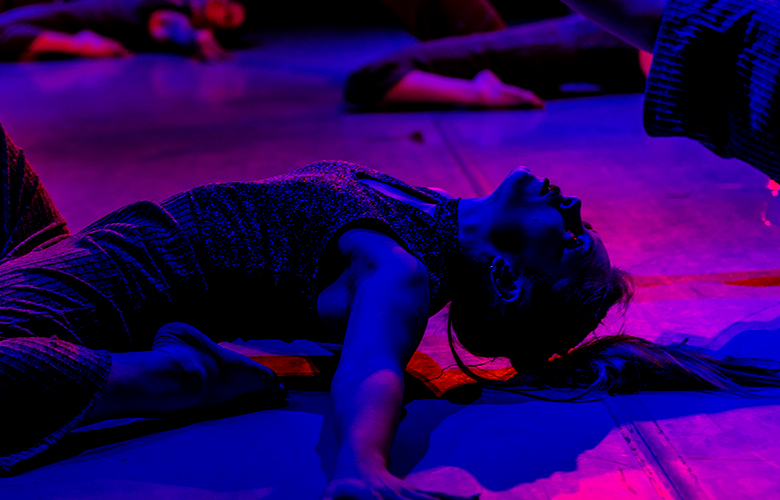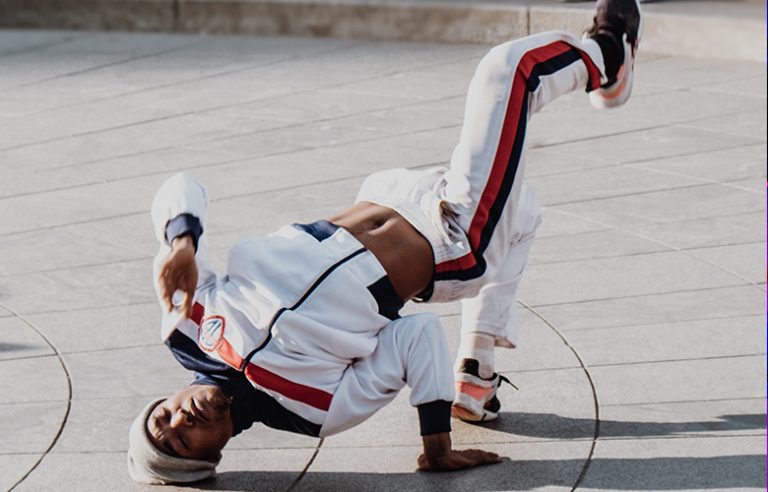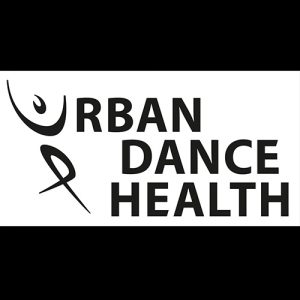
A proper warm-up prevents dance injuries and improves the dancer’s performance. So how does a proper warm-up of a bboy or bgirl look like, especially at competitions? In this article the benefits and mistakes during warm-up, as well as an example of training halos/tracks are described.
First of all, the duration for a proper warm-up should be 10-15 minutes. Performing warm-up efficiently, 15 minutes is enough. After an efficient warm-up, the body feels ready to break with full energy and force.
The idea is to start at the top with very basic and familiar movements and then continue to more challenging movements on the floor. The warm-up should end with breaking related movements which already test the full movement patterns needed in your breaking training later.
The goal of the first part is to increase your heart rate with very basic and safe movements. This can include different kinds of jumping jacks, running, top rocks, jumping, etc. Like in every other part, it is recommended to start from the easiest and simplest of movements. Intensity should grow gradually.
At the second part, the idea is to challenge the body on the floor level while being on all fours. Functional movement will activate the whole body utilizing different kinds of body-weight training moves, for example push ups and animal moves such as tiger, rabbit and bear. In this section you can do part of the moves which you are planning to focus on in your practice. Here is an example: if you are planning to practice six step (a footwork pattern) you can use the positions needed in six step in your warm-up. For example, this could mean choosing the back position from six step and moving forward.
The last section of the warm-up includes breaking related moves. The idea is to perform very basic breaking moves which are easy for the dancer. This section can include for example six step and sweeps. You can also do combinations, such as knee freeze – back sweep – baby freeze. In this section you can focus on your weak points, so eventually you will achieve a more balanced body. You can use this part for mastering the basics. Start easily, but increase the intensity to the maximum. The goal is to have total certainty and confidence in those moves, so you can continue with full force and speed to more advanced training.

Halo is a breaking move which belongs to the powermove category. Powermoves require a high level of coordination and control. Other powermoves are for example back spin, head spin and windmill. Halo requires a good control of basic freeze positions (stationary breaking move) and a control of balancing only on your head. When breaking the move down, you can add these parts to your warm-up.
Secondly, you can focus strengthening your core and arms with versatile push ups. Thirdly, you can drill back sweep to baby freeze on both sides. After this, you can progress to back sweep to head swipe to baby freeze combination on both sides. Using these moves before your actual halo-practice as a warm-up will get you faster to your goals and will minimize injuries at the same time.
Every breaker is an individual, so each breaker should find the best way for themselves. There is no single way of a perfect warm-up which suits everybody. In order to develop it is important to update and change your warm-up regularly. It is beneficial to perform the warm-up barefoot. With bare feet your ankles and knees get much more efficient training. In addition, it is generally beneficial to practice movements bare foot.
A warm-up is basically simple to do, but the following mistakes can occur while performing the warm-up:
First of all, it is important to listen to your body signals. Are you tired or already injured? Noticing and reacting to these messages is crucial. On the other hand, you might notice that your body feels really good after the warm-up and this will give you confidence in your training. Another mistake is to perform warm-ups in a sloppy way and not with full concentration. Being careless in your warm-up will increase the risk of injuries. Finally, it is important to have a balance with the different parts in your warm-up and not doing one thing too many times.
Warm-ups at a competition can be performed with the same pattern used during practice. Before competitions it is important to have the right feeling and confidence. Warm-ups can be done already before you go to the venue, which makes it possible for you to start dancing right away when you hear the DJ playing the music at the venue. This way you will have enough time to gather confidence by dancing. During dancing in the cyphers (circle of breakers where one dances in the middle) it is possible to apply the warm-up pattern as follows:
Starting the solos with a few top rocks (breaking while standing) will get your heart rate up. Go downs (transition from top to floor) and footwork (breaking on the floor) will ensure that your whole body is activated. In order to have full confidence in the session, finish with a few complete solos.
In order to save your energy for the competition, you want to keep your warm-up short and not over 15 minutes. Dancing in the cyphers more than that will decrease your energy for the battles. Performing a good warm-up at the beginning, one does not need to do much before each round of the competition. Before each round a few functional movements might be enough to ensure your body is ready.
A warm-up can be seen as scanning the body. During the warm-up you feel whether your body is in good shape or if there are any injuries. Is your body today working better than yesterday? If your body works well at the warm-up, it gives you more confidence in the rest of your practice. On the other hand, you might notice tiredness. All this information will tell you what you should and what you should not do during the practice. Reacting to these messages is crucial in avoiding over-stressing of the body which leads to injuries.
The warm-up is a wake-up call for the body to be ready for the training including rising in body temperature, increasing heart rate and activating your nervous system.
Additionally, warming up is a transition to the actual practice. Warm-up and practice should not be totally different parts. The warm-up begins the process of learning and you can learn new things already at it. During the warm-up you can develop speed, strength and coordination. By developing your overall physical condition in your warm-up it is less likely to suffer from injuries. Dancers might not do any physical training in addition to the dance training – so it is good to have it in your warm-up. When dancers warm up regularly, the body will adapt to it, so there is no need to stress about it at competitions. The body will warm up faster and you are ready to start dancing at the competitions with a short warm-up or without any warm-up at all.
Breakers generally might warm-up enough, if you only consider the duration. Duration does not say anything, though. Often a warm-up is not an effective part of the practice, where you learn new moves. Breakers might use the same pattern for warm-ups for years and they do not update it enough often. Breakers might have practice sessions, where the whole practice is kind of a warm-up including sitting and stretching on the sides and trying something in the middle.

A breaker can choose his or her own approach to breaking and warming up. One can choose a more sport related way or stay more close to breaking. Approach can also vary depending on the situation. There might be one warm-up routine for practice sessions and another for jams and competitions. The environment and situation might be totally different between training at the gym and at the venue of a jam, so it is smart to apply your warm-up according to the situation.
Breakers might find it hard to get motivation for a proper warm-up. It depends on how one understands a warm-up. One will not have motivation for warming up, if one sees it as something you have to do without getting something out of it. By experiencing the benefits of a proper and planned warm-up in your breaking training and in one’s body, this opinion might change. An easy way is to try and find out, whether there is any effect on your training.
Finally, the term warm-up itself might cause misunderstanding. The use of the term warm-up automatically separates warm-up and training. Forget the term warm-up and think only about the proper progression of the training. As a teacher, stop talking about warm-up and start training with moves which prepare the body for the following movement.
Using warm-up regularly won’t be visible to the outside so much when you are in your 20s, but the difference can be seen with older breakers. With older breakers there is a significant difference within the dance. Warming up and taking care of your body play a big role in it. B-boy Storm is a good example of how good breaking can be despite the age because he really takes care of his body.
It must be remembered that injuries are followed with more injuries. An injury leaves a mark forever and breakers must adapt to it. Because of an injury one might need to change his or her way of breaking and even stop doing certain moves. So it is not the same how young breakers warm-up and take care of their bodies, even though they have not had injuries yet.
MATTI PULKKINEN
Bboy since 2002
Physiotherapist
Facebook: Matti MattiWatti Pulkkinen
Matti Pulkkinen aka MattiWatti is a physiotherapist with a strong breaking background. He started breaking in 2002, and nowadays he travels all around the world. In 2015 he won the crew battles in Finnish Championships with his crew Joensuu Bboys. Matti finished his physiotherapy studies in Jamk University of Appliend Sciences in 2015. He begun to focus on dancers during an internship working at a dance school and currently he is training in the dance school Åsa folkhögskola, Sweden.
Also By Urban Dance Health:
Breakdancing Injures: Common Damage Areas And Causes


Urban Dance Health (UDH) is located in Stuttgart, Germany. It consists of a team of three physiotherapists who are internationally established dancers themselves, so they know both the requirements and the needs of dancers. They regularly conduct health workshops for dancers and dance teachers, offer health checks at events and publish tutorials and articles in the Urban Dance Health Blog. The Urban Dance Blog covers topics such as injury prevention, rehabilitation and regeneration as well as scientific research about how to maintain a long and healthy dance career. In order to promote the health of dancers in a sustainable way, UDH now also trains medical professionals in dance medicine. Doctors and therapists require the right tools to respond to the needs of dancers. This creates a worldwide network of health experts who enable interdisciplinary health care for dancers.
Read Full Profile© 2021 TheatreArtLife. All rights reserved.

Thank you so much for reading, but you have now reached your free article limit for this month.
Our contributors are currently writing more articles for you to enjoy.
To keep reading, all you have to do is become a subscriber and then you can read unlimited articles anytime.
Your investment will help us continue to ignite connections across the globe in live entertainment and build this community for industry professionals.